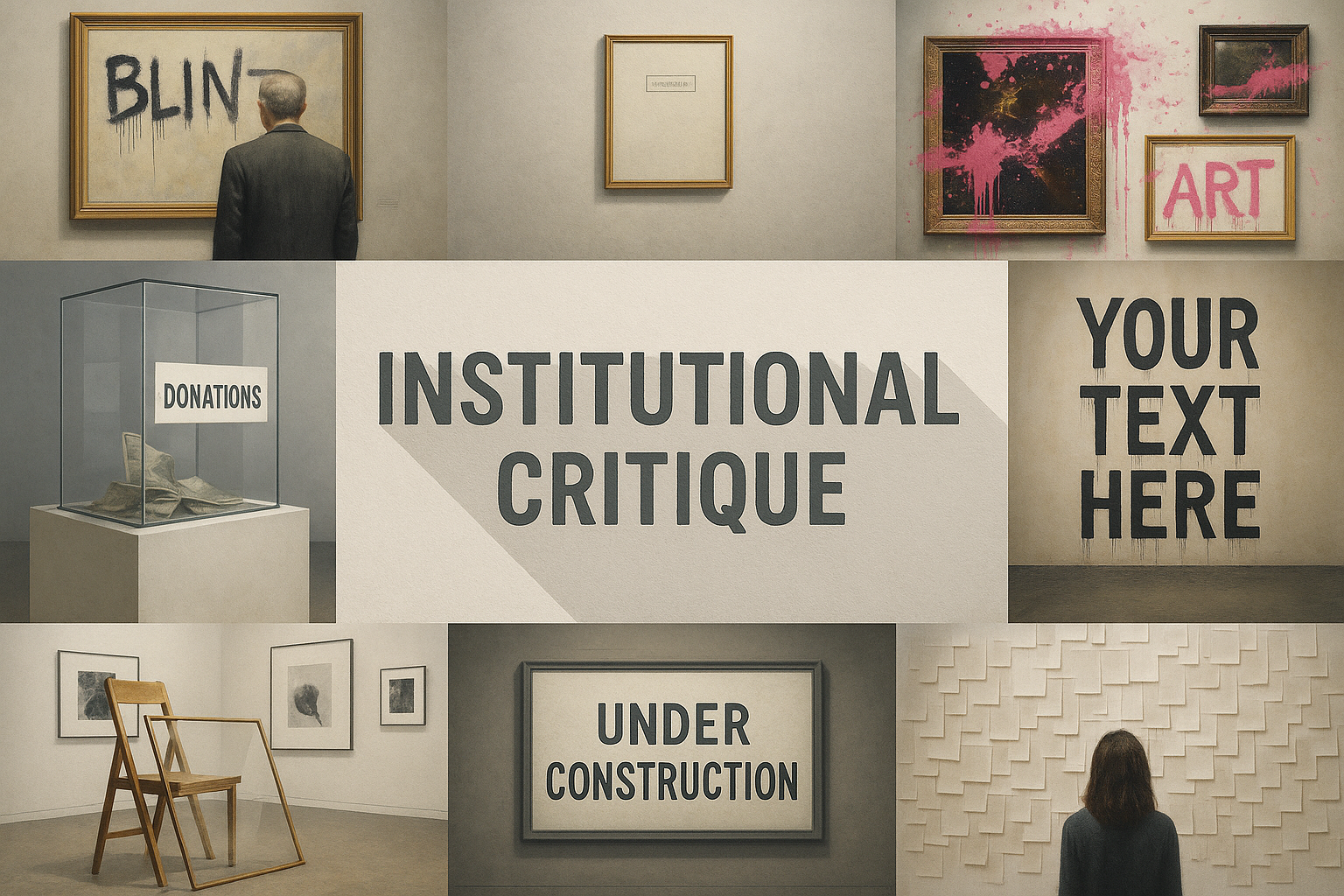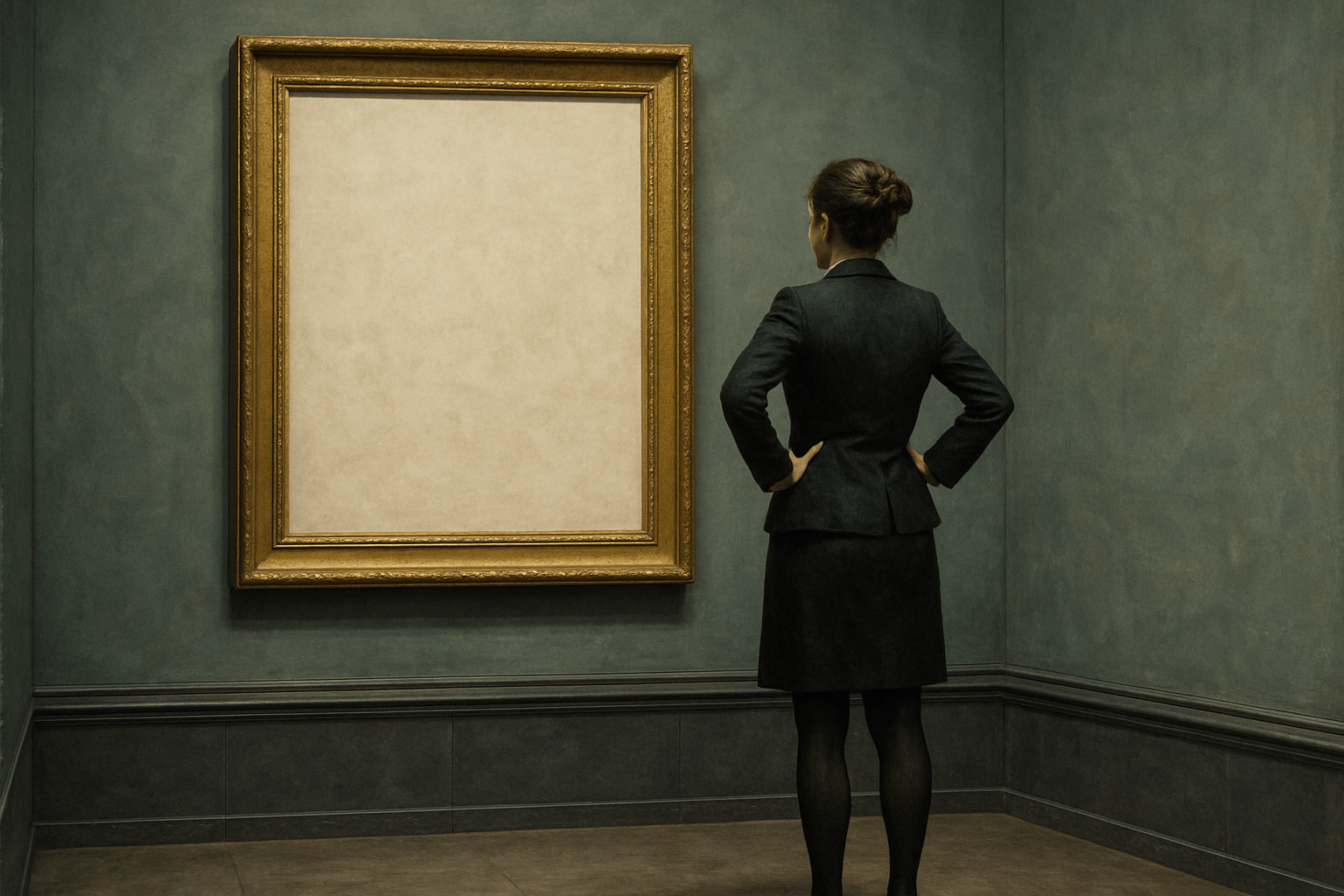
Institutional critique
The art style of institutional critique is characterized by its clean, simple lines and its focus on the institutional structures that support the art world. This style is often critical of the institutions that support the art world, and its goal is to expose the ways in which these institutions can be used to control and manipulate the art world.
AOI thinking about Institutional critique [+_~]-/
Overview and Quickfacts
Institutional critique is an art movement that began in the late 1960s as a reaction to the traditional art world. It is characterized by its focus on the institutions that support the art world, such as museums and galleries, and its criticism of these institutions.
Can understand it also, as:
Art criticism, art theory, and philosophical speculation about art
Categorize it as:
Impressionism, Modernism
.: Dreaming :.
holds a HAIKU for the art style
:. Thought is power .:
Detailed Description
Institutional Critique is an art movement that began in the 1960s and critiques the institutions that house, support, and display art. The goal of the movement is to make these institutions more transparent and accountable. Famous artists associated with institutional critique include Marcel Duchamp, Hans Haacke, and Michael Asher. These artists sought to challenge the conventions of the art world and to make a statement about the role of the artist in society. One famous painting associated with institutional critique is Duchamp’s “Fountain.” This work was a urinal that Duchamp submitted to an art exhibition. The work was rejected by the exhibition’s organizers, but it went on to become one of the most famous and controversial works of art of the 20th century. Institutional critique has been a powerful force in the art world, and its impact can still be seen today.
.. beep, beep, beep ..
<START OF TRANSMISSION>
1. Institutional critique is a form of art criticism that examines the role of art institutions in the production and dissemination of art. 2. It is often associated with the work of Marcel Duchamp, who critiqued the art world's reliance on the traditional art object. 3. Institutional critique has been taken up by a number of artists, including Hans Haacke, Michael Asher, and Andrea Zittel. 4. These artists often use the gallery or museum as their canvas, challenging the institution's authority through their work. 5. Institutional critique has been a controversial form of art, with some critics arguing that it is destructive and negative. 6. Others have praised it as a necessary and important form of criticism. 7. The term "institutional critique" was first coined by German art historian Benjamin H. D. Buchloh in a 1968 essay. 8. Buchloh's essay was a response to the work of Hans Haacke, who he saw as the first artist to truly challenge the institution of the art world. 9. In the 1970s, a number of artists associated with the Conceptual art movement began to engage in institutional critique. 10. These artists saw the institution of the art world as being constraining and limiting to the potential of art. 11. They sought to challenge and subvert the art world's power structures through their work. 12. In the 1980s, Andrea Zittel emerged as a leading figure in the institutional critique movement. 13. Zittel's work often critiqued the commodification of art and the way that the art world values objects. 14. In the 1990s, a number of artists associated with the relational aesthetics movement began to engage in institutional critique. 15. These artists sought to challenge the way that art is produced and consumed within the institution of the art world. 16. In the 2000s, a number of artists associated with the post-internet art movement began to engage in institutional critique. 17. These artists sought to challenge the way that the internet has changed the way that art is produced and disseminated. 18. Institutional critique has been a controversial form of art, with some critics arguing that it is destructive and negative. 19. Others have praised it as a necessary and important form of criticism. 20. Institutional critique is an ongoing form of art criticism that continues to evolve in response to the changing landscape of the art world.
<EOF>
.. robbel bob
Visual Examples from our image gallery
Coming soon, we are so slow .. might never come
Artists, Paintings, and more
(be aware, can be highly speculative)
Artists (be aware, speculation possible):
1. Marcel Duchamp (1887-1968) 2. Richard Hamilton (1922-2011) 3. Ed Ruscha (1937) 4. Lawrence Weiner (1942) 5. Hans Haacke (1936) 6. Dan Graham (1942) 7. Gordon Matta-Clark (1943-1978) 8. Michael Asher (1943) 9. John Baldessari (1931) 10. Mel Bochner (1940) 11. Richard Long (1945) 12. Bruce Nauman (1941) 13. Vito Acconci (1940-2017) 14. Robert Smithson (1938-1973) 15. Dennis Oppenheim (1938-2011) 16. Carl Andre (1935) 17. Richard Serra (1939) 18. Judy Chicago (1939) 19. Eva Hesse (1936-1970) 20. Yoko Ono (1933) 21. Liza Lou (1969) 22. Cady Noland (1956) 23. Paul McCarthy (1945) 24. Mike Kelley (1954-2012) 25. Jeff Koons (1955) 26. Damien Hirst (1965) 27. Maurizio Cattelan (1960) 28. Pierre Huyghe (1962) 29. Takashi Murakami (1962) 30. Banksy (1974)
Artworks (be aware, speculation possible)
1. “The Dinner Party” by Judy Chicago (1974) 2. “Fountain” by Marcel Duchamp (1917) 3. “Portrait of the Artist as a Young Man” by Jackson Pollock (1950) 4. “The Persistence of Memory” by Salvador Dali (1931) 5. “Nude Descending a Staircase, No. 2” by Marcel Duchamp (1912) 6. “American Gothic” by Grant Wood (1930) 7. “The Scream” by Edvard Munch (1893) 8. “The Starry Night” by Vincent van Gogh (1889) 9. “The Birth of Venus” by Sandro Botticelli (1486) 10. “Mona Lisa” by Leonardo da Vinci (1503-1519) 11. “The Last Supper” by Leonardo da Vinci (1495-1498) 12. “Guernica” by Pablo Picasso (1937) 13. “The Night Watch” by Rembrandt van Rijn (1642) 14. “The Hay Wagon” by Andrew Wyeth (1953) 15. “Dogs Playing Poker” by Cassius Marcellus Coolidge (1873) 16. “The Mona Lisa” by Leonardo da Vinci (1503-1519) 17. “The Last Supper” by Leonardo da Vinci (1495-1498) 18. “The Creation of Adam” by Michelangelo (1512) 19. “The Sistine Chapel Ceiling” by Michelangelo (1512) 20. “The Birth of Venus” by Sandro Botticelli (1486) 21. “The Persistence of Memory” by Salvador Dali (1931) 22. “Nude Descending a Staircase, No. 2” by Marcel Duchamp (1912) 23. “Fountain” by Marcel Duchamp (1917) 24. “Portrait of the Artist as a Young Man” by Jackson Pollock (1950) 25. “American Gothic” by Grant Wood (1930) 26. “The Scream” by Edvard Munch (1893) 27. “The Starry Night” by Vincent van Gogh (1889) 28. “The Hay Wagon” by Andrew Wyeth (1953) 29. “Dogs Playing Poker” by Cassius Marcellus Coolidge (1873) 30. “The Dinner Party” by Judy Chicago (1974)
Epoch
The time period of the art style institutional critique is the late 20th century to the present.
AI ART RESSOURCES (AKA, well Tools)
Helping tools -> predefined search links on other pages:











